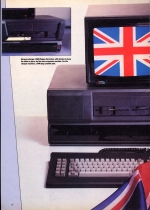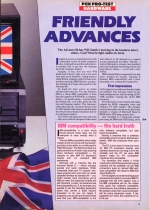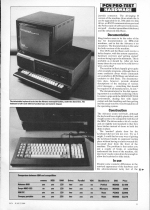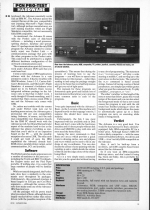
Personal Computer News
 23rd June 1984
23rd June 1984
Categories: Review: Machine
Author: Geof Wheelwright
Published in Personal Computer News #066
The Advance 86 has WHSmith's backing in the business micro stakes. Geof Wheelwright studies its form.
Friendly Advances
The Advance 86 has WHSmith's backing in the business micro stakes. Geof Wheelwright studies its form
Imagine you were a retail chain store with a successful record of home computer sales, looking for a surefire and relatively painless way to get into the business personal computer market.
Imagine, in fact, that you were WHSmith and it doesn't take a lot to see what your next move would be. Along comes a small British company with Ferranti connections and a big, IBM-like box: you have the makings of a major sales push for the Advance 86.
So much for what you've no doubt already read in the ads. Yes, the Advance 86B is a cheap IBM compatible, it does have the support of WHSmith, a company which - it's worth noting - has not taken the Sinclair QL as its entry point into the low-end business market. The Advance, rather than the QL, has been chosen to do for WHSmith in the business market what the two previous Sinclair machines did for it in the home market.
The ZX81 and Spectrum were safe bets - they were each the cheapest of their kind and offered to fill demand in a market no-one questioned was there. The QL - with its Microdrive storage, non-standard and as yet unfinished operating system and long delivery delays - is not such a sure winner.
IBM compatibility is supposed to be this year's formula for success. Advance is claiming IBM compatibility and a price advantage over comparable equipment.
First Impressions
At first glance it would seem that the claims are justified. The Advance comes in two basic configurations, the first being a £399, 128K machine running the 16-bit 8086 processor.
Even this basic version comes with video outputs for RGB, composite video and ordinary TV (RF output). The cheaper version (hereafter known as the 86A) also includes a version of Microsoft Basic in ROM and a DIN-plug cassette port.
Also standard is a Centronics printer port using an IBM-style DB25 plug, and a joystick connector. The all-singing B version of the machine (from which the A can be upgraded for £1,100) adds two disk drives, an RS232 communications port and the Perfect suite of software (word processor/spell checker/spreadsheet/database) and the enhanced disk-Basic.
Documentation
Ring-binders seem to be the order of the day for documentation on IBM-style machines, and in this the Advance is no exception. the documentation is the same for both vesions of the machine.
The DOS and the Basic each receive a hefty chapter, with the system expansion, hardware overview and 'getting started' sections being kept to the minimum. This is probably as it should be. After all, how many times do you need to be told how to wire a new plug?
The section on Basic happily gives quite a few example programs, although there is some confusion about which commands are available in ROM Basic and which are exclusive to disk Basic. The documentation does, however, provide detailed descriptions of the meaning of various error messages - something that should be required of all manufacturers, by law.
The documentation for the disk operating system is a creditable rendering of how to come to grips with the MSDOS/PCDOS environment, dealing first with input/output and disk-handling and then getting into the usual word-by-word breakdown of the operating system.
Construction
The Advance seems well-built, although the keyboard has a slightly plastic feel, and weight seems to be compatible with that of the IBM. The drives make a bit of a racket and are slightly non-standard in that they have latches instead of doors to hold the disks in place.
The 'smoked' plastic door for the keyboard did not win me over. Try as I might, I could find no easy way of getting the keyboard inside its supposed resting place without having to almost wrench the too-small door from the front of the machine. The problem is that unless you put a couple of books or something underneath the front of the machine, the door won't easily come down far enough to allow the keyboard to slide inside.
In Use
Despite some cosmetic differences in the outward appearances of the hardware and the aforementioned tacky feel of the keyboard, the Advance essentially works like an IBM PC. The Advance passed the current flavour-of-the-year compatibility test (running Microsoft's Flight Simulator), although perhaps manufacturers are now making machines which are Flight Simulator compatible, but not necessarily fully IBM-compatible.
As mentioned, the Advance B comes with the Perfect suite of disk-based software - including a word processor, spelling checker, database and spreadsheet. It's perhaps ironic that the only IBM program the Advance seemed to consistently reject was Perfect Link - a communications package that goes with the other programs in the Perfect suite. This could well be attributed to a slightly different hardware configuration of the on-board communications card.
The communications port did, however, work under Advance DOS such that you could send text.
I tried a wide range of IBM applications software with the Advance in a vain attempt to crash it. It had no troubles with IBM Wordstar, Lotus 1-2-3, Caxton Software's Brainstorm, and Microsoft's Flight Simulator. A moment's foolishness even urged me to try Softsel's Open Access integrated software package on the Advance only to find that it didn't work. I really thought I'd found something, until I realised that Open Access needs 256K to run and the Advance only comes with 128K.
So, unless my troubles with the comms port under Perfect Link turn out to be anything more serious, the Advance gets a provisional 100 per cent compatibility rating. Software, of course, isn't the only true compatibility test. Expansion boards for the IBM PC should work with the Advance as well, but I found that particular aspect of the machine hard to test as the Advance has almost everything as standard that you'd add in as an expansion board on the PC - with the possible exception of an extra 128K. The only cards I could get hold of gave the IBM capabilities the Advance already had: RGB colour, parallel printer output, serial communications, I/O and joysticks.
Software
The Perfect suite has made appearances on a number of machines in the past year - including the Torch and BBC Torchpack, the Kaypro series and the Pied Piper portable. If nothing else, it is a suite that large numbers of people will be familiar with.
While not exactly integrated, the Perfect suite does have a similarity in the commands used throughout its packages. Unfortunately, this command structure is based largely on ESCape and ConTRoL sequences - although this version of the suite does make some use of the Advance/IBM function keys.
All the packages will do pretty much what you expect of them, although they are largely manual-driven rather than menu-driven (with the possible exception of the spreadsheet). This means that during the process of learning how to use the programs - you will have to spend some time poring over the manual - rather than rushing in and using the package straight away in the hope that overlaid help menus will get you out of tight spots.
The manuals for these programs are fortunately quite good and include lots of tutorial material that allows you to practise some common tasks in each of the programs.
Basic
I was quite impressed with the Advance's Basic. As the A version of the machine will depend heavily on the language's merits, I suppose this should have come as no surprise.
Unfortunately, the bits I was most impressed with are available only in Disk Basic and don't come with the bare bones machine and it's those people without disk drives and MSDOS to play with who will most need the better Basic.
Among the nicer commands in Disk Basic are CIRCLE, which provides a quick route to drawing circles, arcs and ellipses and PAINT which can be used to fill in any shape at any co-ordinates. You can also decide the colour of your painting with the variables p and e, which decide the colour of the fill and the edge colour of the object being filled.
PLAY is a very simple music command that lets you do a great deal without having to use a lot of programming. The statement PLAY "O3CDEFGABO4C" will play a scale starting a middle C and moving up to the next octave on the last note. The syntax for the PLAY command is based around strings. Instead of having a series of listed parameters, you simply type within quotes what you want the command to do. To play a middle C, you type PLAY "O3C".
The other 'variables' set the length of the note or notes that follow, pause the overall tempo of the music and you can also select the foreground mode so that a new sound causes the program to wait until the old sound has finished playing, or select the background mode which allows the music to automatically queue up so a Basic program can carry on executing while music is being played.
Verdict
The Advance is a very good deal. You would be hard-pressed to find a similarly-equipped, fully IBM-compatible PC for a better price. Although Sanyo's MBC555 looks a likely competitor - with the same extent of bundled software, two drives and 128K - it isn't as fully IBM-compatible as the Advance.
Also, it can't be built up from a no-drives, sub-£400 cassette-based home micro like the Advance B.
So if you want an IBM-compatible desk-top micro, and don't mind it being big, black and bulky, this is probably the machine to get.
Specification
| Price: | £1,250 (£1,499 including VAT, post and packing) |
| Processor: | 8086 running at 4.77 MHz |
| RAM: | 128K |
| Text: | 80 x 25 |
| Graphics: | 640 x 200 |
| Keyboard: | Detachable, full travel with ten function keys and numeric keypad |
| Interfaces: | Centronics, RGB, composite and UHF video, RS232C communications port, audio cassette interface, provision for two analog joysticks, 3 IBM-compatible expansion slots |
| Storage: | Twin 360K floppy disk drives |
| Languages: | MSDOS, Advance Basic |
| Distributor: | WHSmith, 01-353 0277 |
IBM Compatibility - The Hard Truth
IBM-compatibility is a term much thrown around these days, but not everyone is clear exactly what it means.
The only IBM-compatibility which really matters is the full works and that doesn't just stop at the ability to run Microsoft's Flight Simulator. The flight simulator is a good yardstick but it doesn't say anything about hardware compatibility - the capacity to take IBM PC expansion boards and runs standard IBM peripherals.
Although with a machine like the Advance Model B - which includes parallel and serial interfaces, RGB, composite video and TV outputs, analogue joystick ports and even an audio cassette interface as standard kit - you might already have everything you're likely to need, but expansion boards are still important. Luckily, the Advance has that compatibility too. If, for example, you wanted to use the Quadlink expansion board that carries a 6502 second processor to let you run Apple II programs, you would have to have made sure that your 'IBM-compatible' is not only software compatibile, but also board-compatible.
Having a machine that is software compatible only is not as far-fetched as it seems. IBM has produced three such micros.
The PC Junior doesn't have any room for IBM PC expansion boards, and standard boards are too long to fit in the portable and the XT. So even IBM doesn't make its 'PC compatible' machines fully compatible.
For someone who wants a 16-bit machine for wihch they know lots of good software will be available via the IBM connection, even an 'almost IBM software compatible' like Sanyo's MBC555 will probably do.
For the slightly more demanding buyer who wants to be able to run every IBM PC package that will ever appear, only a full IBM compatible will do. No matter how good the 'software compatible' machines are, the software demands of the people using them could eventually call for some expansion cards. If the capability isn't there, the machine isn't a lot of use.
| Comms | RGB | RAM | Drives | Parallel | VDU | Bundled s/w | DOS | Price | |
| Advance 8GB | yes | yes | 128 | two | yes | no | Perfect | MSDOS | £1,499 |
| Sanyo MBC-555 | no | yes | 128 | two | yes | no | Micropro | MSDOS | £899 |
| IBM PC | yes | yes | 128 | two | yes | yes | None | PCDOS | £2,096 |
| Compaq portable | yes | yes | 256 | two | yes | yes | None | MSDOS | £2,270 |
| Comparison between IBM and compatibles | |||||||||
This article was converted to a web page from the following pages of Personal Computer News #066.





